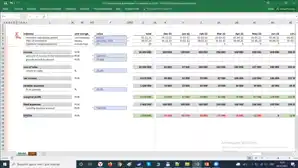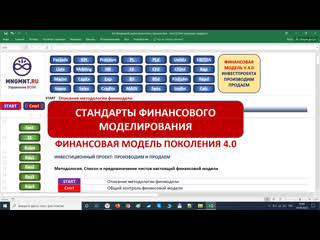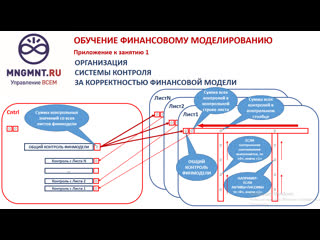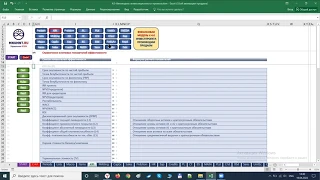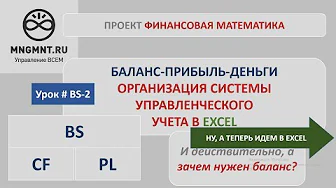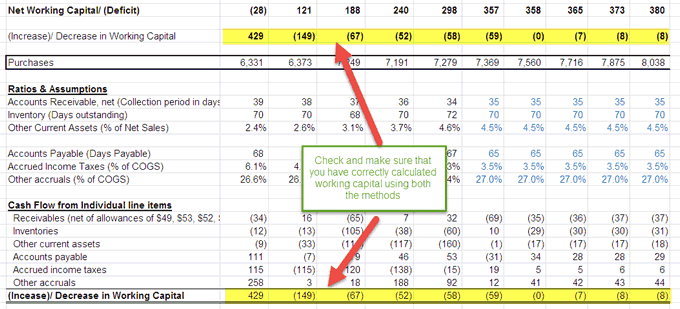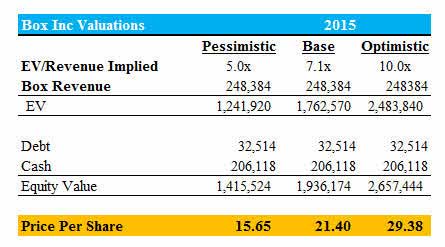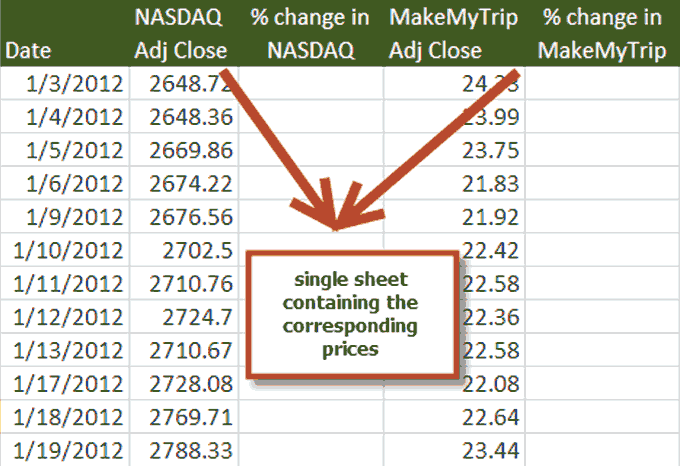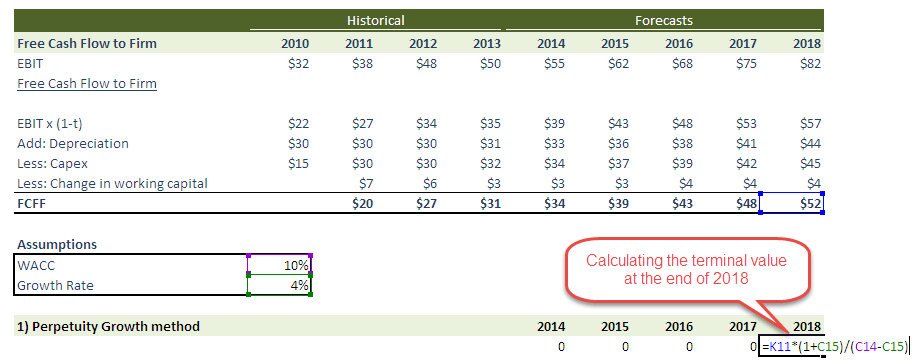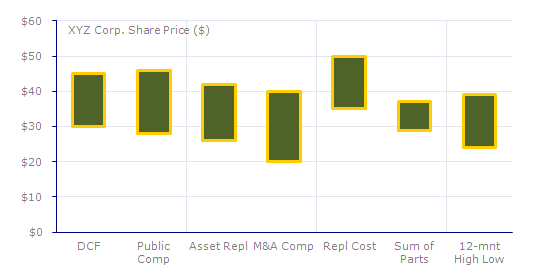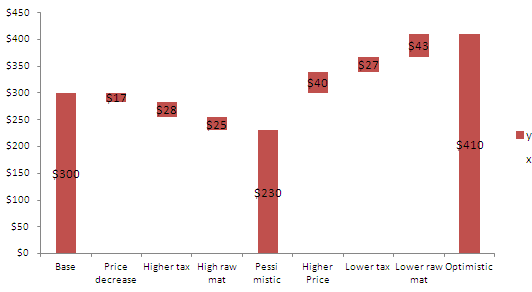Уважаемые посетители!
Скачивайте бесплатно данную финансовую модель со всеми действующими, открытыми формулами ниже в серой рамке, причем как в заполненном виде, для примера заполнения,
так и в незаполненном.
Идентификационный номер этой финмодели: IDFM-100010
Если у Вас нет желания тратить много времени на внесение данных Вашего проекта в условия модели и
плюс к тому Ваш бюджет на создание финансовой модели позволяет, то можем предложить Вам за сравнительно небольшие деньги
воспользоваться услугой заполнения финмодели Вашими данными в нашем
Маркетплейсе финансовых моделей P&L.RU,
либо подписавшись на платный Тариф 2 после регистрации
Смотрите обучающую видео-методологию с нашего Ютуб-канала о том, как прописать действующие формулы данной финансовой модели в EXCEL:
Используйте этот видео-ролик в качестве инструкции для заполнения и корректировок финансовой модели.
Онлайн-версию этой финмодели смотрите здесь:
перейти в онлайн-модель
Описание характеристик финансовой экспресс-модели от 5 параметров:
- Простейшая финмодель для быстрого расчета Вашего бизнес-проекта — носит универсальный характер;
- Данная финмодель помимо представления в EXCEL, имеет онлайн-реализацию;
- Горизонт моделирования неограничен и периодизация может быть ежемесячной, ежеквартальной или ежегодной;
- Доходная часть задается в денежном представлении с динамикой в виде прироста по правилам линейной прогрессии, начинающейся с заданной суммы дохода в начальный период;
- Себестоимость задается через процент рентабельности (маржинальности);
- Переменные расходы задаются единым процентом от дохода;
- Постоянные расходы задаются единой суммой за период.
Успехов Вам в создании финмодели Вашего проекта!
Еще финмодели:
Двуязычная финмодель от 5 параметров со сценариями
Наше обучающее видео
Rutube:
Финансовая модель поколения 4.0
Rutube:
Система контроля за корректностью финмодели в EXCEL
Rutube:
Простая финмодель от 10 параметров и с расчетом IRR, NPV, PBP, ROI и т.п.
Rutube:
Баланс, прибыль, деньги и финотчеты BS PL CF
Rutube:
Организация системы управленческого учета в EXCEL
Rutube:
Курс обучения финансовому моделированию в Excel. Часть1
Вконтакте:
Финансовая модель поколения 4.0
Вконтакте:
Система контроля за корректностью финмодели в EXCEL
Вконтакте:
Простая финмодель от 10 параметров и с расчетом IRR, NPV, PBP, ROI и т.п.
Вконтакте:
Баланс, прибыль, деньги и финотчеты BS PL CF
Вконтакте:
Организация системы управленческого учета в EXCEL
Вконтакте:
Курс обучения финансовому моделированию в Excel. Часть1
YouTube:
Финансовая модель поколения 4.0
YouTube:
Система контроля за корректностью финмодели в EXCEL
YouTube:
Простая финмодель от 10 параметров и с расчетом IRR, NPV, PBP, ROI и т.п.
YouTube:
Баланс, прибыль, деньги и финотчеты BS PL CF
YouTube:
Организация системы управленческого учета в EXCEL
YouTube:
Курс обучения финансовому моделированию в Excel. Часть1
С НАМИ ЭФФЕКТИВНЕЕ!
A Financial Model Template is the summary of a company’s performance, based on certain variables, which calculates the future performance of a business. This type of forecast is established on the company’s historical performance and makes predictions about the future. Financial Model Templates require preparing an income statement, balance sheet, cashflow statement, and supporting schedules (also known as a 3-statement model). Once completed, more sophisticated types of models can be built such as discounted cash flow analysis (DCF Model), leveraged buyout (LBO), mergers and acquisitions (M&A), and sensitivity analysis.
What are Financial Model Templates used for?
Financial Model Templates are used for decision making and performing financial analysis. Within companies, executive use financial models to make decisions about the following:
1. Raising capital, debt, or equity
2. Acquiring businesses or assets
3. Expanding the business organically
4. Selling or divesting assets and business units
5. Budgeting and forecasting
6. Capital allocation
7. Valuing a business
8. Financial statement (ratio) analysis
9. Management accounting
Why is using a Financial Model Template beneficial?
Using a Financial Model Template is quick, easy, and gives you your desired results. Building a Financial Model from scratch can be overwhelming, especially when you don’t know where to begin. Instead, using a template is an attractive option because it requires a much lower initial investment of time and money rather than it would to build your own model.
The Most Common Types of Financial Models
1. The Three Statement Financial Model
This is the simplest form of financial modeling and is comprised of three different kinds of financial statements: the income statement, balance sheet and cash flow statement, all of which use dynamic formulas within Excel. The key idea behind the Three Statement Financial Model is that all three will be interconnected, and the input assumptions can prompt changes within the entire model. A sound basis of core finance, accounting and Excel skills are fundamental to linking these statements together.
2. DCF (Discounted Cash Flow) Model
The DCF model takes the Three Statement Financial Model further in order to estimate a company’s value. This is done using the NPV (Net Present Value) of a business’ future cash flow.
Slight alterations are made to the Cash Flow Statement from the Three Statement Financial Model before the XNPV function in Excel is applied, discounting them back to the company’s present day WACC (Weighted Average Cost of Capital).
Financial models of this kind are primarily used in capital markets and equity research.
3. M&A Models
These are more technical forms of financial models whose aim is to analyse the finances of both mergers and acquisitions, focussing on evaluating its pro forma accretion or dilution. Each of the companies is often represented within a single tab to fit with the idea that Company 1 + Company 2 = Merged company. This kind of model is commonly used in investment banking and corporate development with varying levels of complexity.
4. IPO (Initial Public Offering) Models
IPO models are often built by investment bankers and corporate development professionals before a business goes public in order to estimate its value. These models are based on assumptions of how much investors would be ready to pay for a given company. Within the model, the valuation also includes what is known as an “IPO discount” which is designed to make sure that stocks trade well on the secondary market.
5. LBO (Leveraged Buyout Model)
This is another form of advanced financial modeling which focusses on modeling complex debt schedules. These models are often some of the most difficult and detailed models to create with many intricate layers and circular references as well as the cash flow waterfalls. These models are again most common in private equity and investment banking.
6. Sum of the Parts Models
These models are created by combining numerous different DCF models. Once these have been added together, different elements of a business that may not have been suitable for DCF analysis are then added to the business’ value. As such, this model is a sum of the different elements of a business, its investments and liabilities in order to arrive at the Net Asset Value for the business.
7. Consolidation Models
These models are a combination of various business units within one single model. Each of these business units is typically represented within a single tab. These tabs are then culminated within a consolidation tab which acts as a sum of all the different business units. These models are often similar to the Sum of the Parts models.
8. Budget Model
These kinds of financial models are frequently used by professionals in FP&A (Financial Planning & Analysis) in order to establish a business’ budget for the next year or years. Much of the budget model is heavily based on the information within the business’ income statement and is typically designed to display monthly or quarterly figures.
9. Forecasting Model
Again, these models are often used in FP&A as a means of building forecast estimations that can then be used in comparison and conjunction with the budget model. Budget models and forecasting models are sometimes seen within the same workbook but can also be completely separated from one another.
10. Option Pricing Model
These models are frequently found in two forms: binominal tree models and Black-Scholes models. They are a fairly uncomplicated calculators within Excel as they are based solely on mathematical models.
To find out more about Financial model templates
Financial Modeling
Business Model vs. Financial Model
Benefits of Financial Modeling Course
CFI
What is Finance?
Finance can be defined as the term describing two major intertwined activities:
- the management of money as an asset
- the process of finding necessary funds for projects
Funding is key for all major stakeholders in an economy: individuals, corporations and governments. This is what explains the classical division of the discipline into:
- Personal Finance
- Corporate Finance
- Public Finance
Major activities in Finance, for all of the three categories above include: investing in value-added projects, obtaining the cheapest credit possible, the allocation of funds to back up liabilities and making these operations happen (ie: banking).
More on finance on Investopedia here
Why is Finance key for organizations?
Successful Finance Management is one of the key pillars for a healthy organization. The discipline uses a number of financial instruments (eg: loans, investments, securities) to answer an organization’s financial needs. Good financial management and funding helps organizations fund the assets necessary for their growth (i.e: labor, machinery, equipment, services etc.). Keeping an eye on key financial indicators and using the right financial instruments, tools and strategies is at the heart of an organizations life, survival and expansion. Finance functions can either be in-house, outsourced, used on a temporary basis (Consulting) or, most often, a combination of the three.
How can you get a job in Finance?
Landing a Finance job isn’t easy, as having and using with success the right knowledge is a pre-requisite.
Possible paths to land a job in Finance are:
- o Getting an MBA, Bachelors or Master Degree in Finance
- o Statutory Courses validated by official authorities
- o Chartered Accountants
- o Cost & Management Accountants
- o Specialized Finance Courses
- o CFA (Chartered Financial Analyst)
- o CFP (Chartered Financial Planner)
- o Economics Courses
- o Statistics Courses
- o CAIA (Chartered Alternate Investment Analyst)
- o Financial Risk Manager
- o Financial Modeling and Investment Banking Programs (Offline or Online)
More on getting a Job in Finance on Quora here
How can I acquire the skills and tools used in Finance?
Most Finance professionals, on top of their knowledge, have a set of tools they use for their daily or exceptional operations. They either build them themselves from scratch based on their expertise and experience of a large or specific sector or they use ready-made tools provided by their firm, colleagues or online web-sites.
Eloquens is in this last category, as an intermediary between financial tool authors and financial tool users, with the objective of helping finance professionals building on each other’s work instead of having to reinvent the wheel every time. You will find below, for download and open discussion a number of excel financial models and methodologies by world-class academics, experts and professionals.
To find out more about Finance in general
Finance
What is Finance?
Финансовые модели — Технология бизнеса
В качественно проработанном бизнес плане, независимо от вида деятельности, большое внимание уделяется расчетной части, благодаря которой мы получаем такие важнейшие показатели для бизнеса, как: чистая прибыль, рентабельность, срок окупаемости и прочее.
Данные расчеты интегрируются с другими основными разделами, чтобы на выходе получился полноценный бизнес-план.
Портал «Технология Бизнеса» предлагает готовые финансовые модели, выполненные в виде калькулятора в формате Excel, в которых достаточно подставить лишь свои исходные данные. Все финансовые модели разработаны с учетом особенностей конкретного вида бизнеса и типа отрасли, результат пересчитывается автоматически.
В настоящий момент доступны для скачивания следующие финансовые модели для расчета бизнес-плана:
Автобизнес
- Финансовая модель бизнеса — автомойка на несколько постов
- Финансовая модель бизнеса — мойка самооблуживания
- Финансовая модель бизнеса — сухая автомойка
- Финансовая модель бизнеса — магазин автозапчастей
- Финансовая модель бизнеса — служба такси
Красота и здоровье
- Финансовая модель бизнеса — открытие массажного салона
- Финансовая модель бизнеса — открытие фармакологической аптеки
- Финансовая модель бизнеса — открытие салона красоты с нуля
Мода и стиль
- Финансовая модель бизнеса — парикмахерская эконом класса
Продукты и напитки
- Финансовая модель бизнеса — продажа и производство сахарной ваты
- Финансовая модель бизнеса — производство мороженого
- Финансовая модель бизнеса — мини завод по производству колбасных изделий
- Финансовая модель бизнеса — открытие собственной мини пивоварни
- Финансовая модель бизнеса — открытие продуктового магазина у дома
- Финансовая модель бизнеса — производство домашних пельменей
- Финансовая модель бизнеса — открытие кондитерского магазина
- Финансовая модель бизнеса — мобильная кофейня на колесах
- Финансовая модель бизнеса — «кофе с собой» точка продаж
- Финансовая модель бизнеса — молодежное кафе
- Финансовая модель бизнеса — открываем пекарню
- Финансовая модель бизнеса — производство мясных полуфабрикатов (котлеты)
- Финансовая модель бизнеса — расчет открытия ресторана
- Финансовая модель бизнеса — еда по подписке
- Финансовая модель бизнеса — магазин разливного пива
- Финансовая модель бизнеса — рыбный магазин
- Финансовая модель бизнеса — ларек с шаурмой
- Финансовая модель бизнеса — кальянная
Производство
- Финансовая модель бизнеса — производство плитки из резиновой крошки
- Финансовая модель бизнеса — цех по производству мебели
- Финансовая модель бизнеса — переработка пластика и пластиковых бутылок
- Финансовая модель бизнеса — производство полиэтиленовых пакетов
- Финансовая модель бизнеса — производство тротуарной плитки
- Финансовая модель бизнеса — мини завод по производству товарного бетона
- Финансовая модель бизнеса — производство бумажных пакетов
- Финансовая модель бизнеса — собственное производство пеноблоков
- Финансовая модель бизнеса — производство пеллет
- Финансовая модель бизнеса — производство саморезов
- Финансовая модель бизнеса — производство гробов из картона
- Финансовая модель бизнеса — завод по переработке и утилизации шин
- Финансовая модель бизнеса — мусороперерабатывающий завод
Разведение и выращивание
- Финансовая модель бизнеса — разведение и содержание кроликов в домашних условиях
- Финансовая модель бизнеса — выращивание бройлеров в подсобном хозяйстве
- Финансовая модель бизнеса — сбор меда и выращивание пчел
- Финансовая модель бизнеса — разведение и продажа индоуток (мускусная утка)
- Финансовая модель бизнеса — бизнес по разведению раков
- Финансовая модель бизнеса — ферма по разведению дождевых червей на продажу
- Финансовая модель бизнеса — разведение цесарок в подсобном хозяйстве
- Финансовая модель бизнеса — ферма по разведению осетра на мясо и икру
- Финансовая модель бизнеса — крестьянско-фермерское хозяйство
- Финансовая модель бизнеса — как правильно вырастить рассаду на продажу
- Финансовая модель бизнеса — мобильная бойня скота
Развлечения и спорт
- Финансовая модель бизнеса — фитнес клуб с бассейном
- Финансовая модель бизнеса — ночной клуб
- Финансовая модель бизнеса — как открыть тренажерный зал
Торговля
- Финансовая модель бизнеса — открытие зоомагазина
- Финансовая модель бизнеса — магазин женской одежды
- Финансовая модель бизнеса — комиссионный магазин
- Финансовая модель бизнеса — цветочный бизнес
Услуги
- Финансовая модель бизнеса — агентство по организации праздников
- Финансовая модель бизнеса — прокат инструмента
- Финансовая модель бизнеса — частный детский сад
- Финансовая модель бизнеса — создание фотостудии
- Финансовая модель бизнеса — ателье по пошиву и ремонту одежды
- Финансовая модель бизнеса — клининговая компания
- Финансовая модель бизнеса — открытие хостела
- Финансовая модель бизнеса — свой ломбард
- Финансовая модель бизнеса -гостиничный бизнес
- Финансовая модель бизнеса — ассенизаторский бизнес
- Финансовая модель бизнеса — школа рисования
- Финансовая модель бизнеса — расчет открытия антикафе
Бесплатно скачать образец финансовой модели для расчета бизнес-плана.
Чтобы получить файл с интересующей вас финансовой моделью в формате Excel, пожалуйста заполните форму обратной связи ниже, в тексте письма укажите название необходимого финансового расчета, либо иной заказ.
-
Стоимость одного файла с финансовой моделью бизнес-плана составляет — 299 рублей.
-
Внесение изменений в финансовую модель по исходным данным специалистом портала (ИП, ООО на УСН) — 699 рублей. - Внесение изменений в финансовую модель по исходным данным специалистом портала (ОСНО НДС) — 799 рублей.
-
Разработка финансовой модели для бизнеса (по исходным данным заказчика) — 1499 рублей.
Пожалуйста, подтвердите, что вы человек:
красный
зеленый
оранжевый
фиолетовый
— Выберите фиолетовый квадрат
* Все поля обязательны для заполнения
Выложил для ознакомления шаблоны финансовых моделей (без формул) инвестиционных проектов в Формате Excel:
1. Большая и подробная финмодель на шаблоне Фонда развития промышленности (скачать)
2. Очень простая финансовая модель промышленного производства для знакомства с темой (скачать)
3. Финансовая модель проекта строительства жилого дома (скачать)
Если нужно разработать финансовую модель любой сложности — обращайтесь!
Все готовые финансовые модели на этой странице.
Для заказа воспользуйтесь формой обратной связи на сайте или напишите письмо, и мы обсудим варианты оплаты.
Financial Modeling is the forecast of the company’s financial fundamentals based on its past and the expected future. Here you can download 11 Financial Modeling templates for free, including the Alibaba IPO model, Box IPO Model, Colgate Financial Model, Beta calculation, Free Cash Flow to Firm Model, sensitivity analysis model, comparable company analysis model, PE and PE Band Chart, Scenario Model and Football Field Chart.
Download All IB Templates
Table of contents
- Financial Modeling Excel Templates
- #1 – Alibaba IPO Template
- #2 – Colgate Financial Model Excel Template
- #3 – Box IPO template
- #4 – Beta Calculation Worksheet – MakeMyTrip
- #5 – Terminal Value Calculation – Excel Template
- #6 – Free Cash Flow Excel Template
- #7 – PE Chart Template & PE Band Chart Excel Template
- #8 – Football Field Graph
- #9 – Scenario Graph Template
- #10 – Comparable Company Valuation Model Template
- #11 – Sensitivity Analysis
- Recommended Articles
#1 – Alibaba IPO Template
In May 2014, Chinese E-commerce biggie Alibaba filed for its IPO in the US. I created its financial model from scratch. You will learn Alibaba’s 3 statement forecastsAlibaba is the most profitable Chinese e-commerce company and its IPO is a big deal due to its size. With its huge size and network, Alibaba IPO may look at international expansion beyond China and may lead to price wars and intensive competition in the US.read more, interlinkages, DCF Model – FCFF, and Relative Valuation through this template.
#2 – Colgate Financial Model Excel Template
This Colgate Financial model is a part of the Financial Modeling in Excel, where there are two templates – solved and unsolved financial models of Colgate. You can start with Colgate’s unsolved model and follow the tutorial to create a complete Financial model.
#3 – Box IPO template
In March 2014, Box filed for registration documents for IPOThe analysis of the Box IPO valuation can be done using various methodologies which are Relative Valuation – SaaS Comparable Comps, Comparable Acquisition Analysis, Using Stock-Based Rewards, Valuation cues from Private Equity Funding, Valuation cues from Dropbox Private Equity Funding, and Discounted Cash Flow Approach for Box IPO Valuation.read more in the US to raise $250 million. Here I created another template from the start and covered its projection of financial statements of BoxThe significant risk factors of box IPO are — box sales & marketing costs is three times the average, Box Inc will require $1.25 billion in the next five years to survive, management owns less than expected, OpenText seeking $268 million in damages in a patent infringement lawsuit, competitors.read more, valuations, and target recommendations.
#4 – Beta Calculation Worksheet – MakeMyTrip
Beta measures the sensitivity of stock prices compared to the more extensive INDEX. In this excel CAPM modelThe Capital Asset Pricing Model (CAPM) defines the expected return from a portfolio of various securities with varying degrees of risk. It also considers the volatility of a particular security in relation to the market.read more, we calculate the Beta of MakeMyTrip for NASDAQ.
#5 – Terminal Value Calculation – Excel Template
Terminal Value is the value of the company after the forecast period. It is a fundamental concept as more than 60-80% of the total amount is derived from the Terminal value. This excel template provides two ways to calculate the Terminal valueTerminal Value is the value of a project at a stage beyond which it’s present value cannot be calculated. This value is the permanent value from there onwards. read more – Perpetuity Growth method and Multiple Method.
#6 – Free Cash Flow Excel Template
In simple terms, the Free Cash Flow firm is Cash flow from Operations and Cash Flow from Financing. FCFFFCFF (Free cash flow to firm), or unleveled cash flow, is the cash remaining after depreciation, taxes, and other investment costs are paid from the revenue. It represents the amount of cash flow available to all the funding holders – debt holders, stockholders, preferred stockholders or bondholders.read more is the foundation of the DCF techniqueDiscounted cash flow analysis is a method of analyzing the present value of a company, investment, or cash flow by adjusting future cash flows to the time value of money. This analysis assesses the present fair value of assets, projects, or companies by taking into account many factors such as inflation, risk, and cost of capital, as well as analyzing the company’s future performance.read more.
#7 – PE Chart Template & PE Band Chart Excel Template
PE Charts and PE Band Charts are very important from an investment banking point of view. They provide a visual glimpse of how valuations have moved over a while. PE Band Charts can be a bit tricky to make. Download this excel model to learn how to make this chart step by step.
#8 – Football Field Graph
Football Field Chart is very helpful to visually understand the valuation of the firm under various scenarios as well as valuation methodologies. Download this financial modeling template to learn the Football Field Chart.
#9 – Scenario Graph Template
A scene graph is one of my favorites when providing a visual explanation of valuation scenarios. It is a very high-impact graph, and when included in your pitch bookPitch Book is an information layout or presentation used by investment banks, business brokers, corporate firms, and others to provide potential investors with the firm’s main attributes and valuation analysis, which helps them decide whether or not to invest in the client’s business. A pitch book is also known as Confidential Information Memorandum, which is used by the firm’s sales department to help them sell products and services to a client.read more or research report, it can make an excellent impression on your clients. Download this Scenario Graph Template.
#10 – Comparable Company Valuation Model Template
Comparable company analysis is nothing but looking at the firm’s competitors and taking cues from their valuations. However, there is a way to professionally compare the valuation multiple of competitors, and you can download this financial model template to learn excellent valuation techniques. We use relative valuation multiples like PE Multiple, EV to EBITDA, and Price to Cash Flow.
#11 – Sensitivity Analysis
Sensitivity Analysis is fundamental when we have to do Discount Cash Flows and want to check the sensitivity of Fair Price when we change variables like Growth Rates of the Company and Weighted Average Cost of CapitalThe weighted average cost of capital (WACC) is the average rate of return a company is expected to pay to all shareholders, including debt holders, equity shareholders, and preferred equity shareholders. WACC Formula = [Cost of Equity * % of Equity] + [Cost of Debt * % of Debt * (1-Tax Rate)]read more. We use DATA TABLEs in Excel to do this sensitivity analysis.
Recommended Articles
This has been a guide to Financial Modeling Templates. Here we provide you top 11 financial modeling templates, including Alibaba IPO Template, Box IPO template, etc. You can learn more about it from the following articles –
- Financial Modeling – Job Description
- Financial Modeling Interview Questions (With Answers)
- Financial Modeling in Python
- Coursera Financial Model




